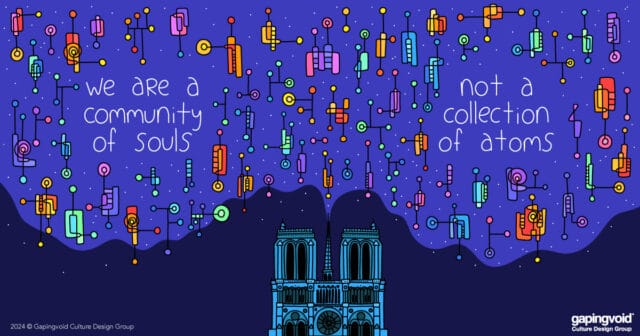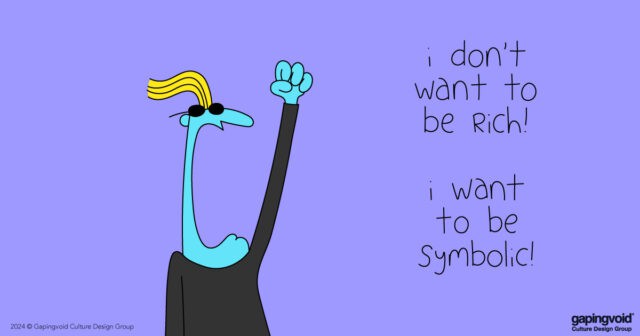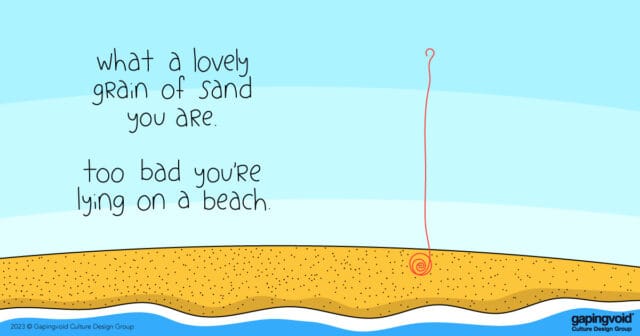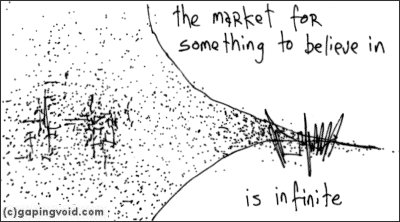
10 Questions For Seth Godin
My friend and mentor, Seth Godin has a new book out, “Tribes”. As has become a regular gapingvoid tradition, to celebrate the launch I e-mailed Seth 10 questions, which he kindly answered below. Rock on.
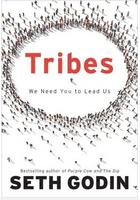
1. For the benefit of gapingvoid readers not yet familiar with your work [all 14 of them], let’s get the main schpiel over and done with: From your perspective, what is “Tribes” about?
It explains why top-down, buzz-driven media is the past, not the future.
The world has always been organized into tribes, groups of people who want to (need to) connect with each other, with a leader and with a movement. The products, services and ideas that are gaining currency faster than ever are ones that are built on a tribe.
Barack Obama has one, John McCain tried to co-opt one. Arianna Huffington has built the most popular blog in the world around one. Harley Davidson and Apple are titanic brands for the very same reason. They sell a chance to join a group that matters.
The punchline is that the only way to lead a tribe is to lead it. And that means that marketing is now about leadership, about challenging the status quo and about connecting people who can actually make a difference. If you can’t do that, don’t launch your site, your product, your non-profit or your career.
I’d argue that you understand how to tap into this need, Hugh. Lots of people don’t like your work–screw them, we don’t like them anyway. The people who do like, who find that it resonates… it’s likely that we’ll like each other. You lead us to a place we want to go.
2. Your seminal bestseller from a few years ago, “Purple Cow”, made the assertion that “Everyone is a Marketer”. Though this would now be considered pretty standard doctrine for marketing geeks Everywhere, at the time I remember it seeming a pretty radical, new, challenging thought. In Tribes, it seems to me you’ve upped the ante by asserting that “Everyone is a Leader”. Care to elaborate?
Sure. The idea that everyone is a marketer is still hard for a surprisingly large number of organizations. Non profits (most of them) don’t see the world that way. Neither do traditional factories or many other businesses. But it’s so clearly true, I don’t even have to outline here how the product is the marketing, how the service is the marketing, how every human being who touches something is doing marketing.
Well, if we go a giant step forward and realize that it is for and about the tribe, that tribes–connected, motivated groups of people–are the engines of growth, then it seems clear to me that what marketing means today is leadership. If you’re boring or staid, no one will follow you. Why would they?
3. Anyone who knows you would consider you a leader, in your own unique way. And the same could be said for a lot of the people you personally hang out with. But it seems to me that this book was not written for those type of folk, but for people who have yet to really consider themselves as leadership material. It seems to me that the main thrust of the book is about trying to get them to make the leap from “Follower” to “Leader”. Is there any truth in that?
Everyone isn’t going to be a leader. But everyone isn’t going to be successful, either.
Success is now the domain of people who lead. That doesn’t mean they’re in charge, it doesn’t mean they are the CEO, it merely means that for a group, even a small group, they show the way, they spread ideas, they make change. Those people are the only successful people we’ve got.
So the challenge is: your choice.
4. As you well know, I’m fascinated with marketing, both for myself and for my clients. Looking over my work from the last couple of years, I increasingly see marketing [by that I mean, GOOD marketing] as a function of LANGUAGE and NARRATIVE. In other words, the art of marketing is figuring out a way to talk to people in the market in a manner they SIMPLY HAVE NOT been talked to before. And then when I’m reading your book, I keep thinking that, SO MUCH of being a leader is simply providing people with a good narrative to explain their actions.
In other words, it’s far easier to lead if [A] You’ve got a great story that’s easy for you to share and [B], more importantly, you have a good story that is EASY for other people to share.
So much traditional marketing is built around the idea of “Merit” i.e. good quality, good prices etc.
But the older I get, I keep asking myself, “What’s the story here? What’s the REAL story that people are GENUINELY going to want to tell other people?” Do you see Storytelling as a form of Leadership? How about vice versa?
In All Marketers Are Liars, my point was that people buy stories, not stuff, and it’s stories that spread, not stuff. An iPod made by Garmin wouldn’t be an iPod, would it? It’s the story and the affect and the whole aura that makes it worth $200.
I think you’ve hit the issue on the head. Leaders tell stories. Gandhi or King or Che or yes, Rush Limbaugh. They tell stories. The stories matter and the words matter. Of course OF COURSE the product has to live up to the story, the service has to be there, the story has to be true. But no story, not idea, no marketing.
5. We all have different things that motivate us, that gets us out of bed in the morning. Some people want money, some people want power, some people want fame and applause. You seem very driven “To Affect Change”, both on an individual level, and collectively within companies. Where does that drive come from? Were you born with it, or has it just grown with you over the years? Is it something that is still constantly evolving? If so, how?
It used to be a curse, but now I’m getting used to it.
I’m pretty impatient with things that are as they are instead of as they could be. I’m impatient with people who grumble and settle and then get old and die. I’m energized by people who see things differently and make changes happen. We’re all so lucky, what a sin to waste it.
6. When I finished reading “Tribes” I was both stunned and delighted in equal measure to see my name cited in the Acknowledgements section as an influence in the creation of the book [Thanks!]:
“Years ago, Hugh MacLeod, the world’s most popular inspirational business cartoonist (who knew you could do that for a living?), drew a cartoon (his most popular one ever) with the caption, ‘The market for something to believe in is infinite’- as soon as I read it, I knew I wanted to write a book about that idea.”
Well, I certainly have some ideas about what that cartoon means to me, though I’d be curious to hear your individual take on it. What it says to you, personally. Thoughts?
That was the second title I had in mind for the book. And I was going to include the image itself, but then it showed up all over the web and so…
The point imho is this: You can’t drink any more bottled water than you already do. Or buy more wine. Or more tea. You can’t wear more than one pair of shoes at a time. You can’t get two massages at once…
So, what grows? What do marketers sell that scales?
I’ll tell you what: Belief. Belonging. Mattering. Making a difference. Tribes. We have an unlimited need for this.
7. Your books and blog posts seem to have one thing in common, they seem to be getting shorter and shorter with every passing year. I have no problem with that; I think people genuinely prefer short reads, over long ones. For people aspiring to publish their own books one day, what advice would you give them re. deciding on a book’s length?
Try to write a book or a blog post that can’t possibly be any shorter than it is.
8. I think aspiring writers have a lot of romantic illusions about “The life of an author”, which have little to do with the actual hard-nose reality of the publishing business. What do you think are the hardest lessons for a first-time author to learn?
Books are souvenirs that hold ideas. Ideas are free. If no one knows about your idea, you fail. If your idea doesn’t spread, you fail. If your idea spreads but no one wants to own the souvenir edition, you fail.
Book publishers don’t make authors successful (clarification: 175,000 new authors a year, 300 become successful because of publishers). Authors make themselves successful by earning the privilege of having a platform, by creating ideas that spread, and yes, by building a tribe. (Harry Potter anyone?)
9. You’re a busy guy. Besides writing books, you have paid speaking gigs, your blog to keep up, and your various start-ups and businesses to manage. When do you find time to write the actual books? Do you have a regular set time for working on it [first thing in the morning, say], or do you just somehow find the time whenever?
I don’t set out to write books. I don’t make time for them. They just force themselves on me. If I resist, the idea makes me miserable until I write it down.
I can go three or six months or longer with nothing, and then an entire book just sort of appears. If I have to grind it out, I’m not going to write it. That’s not true for everyone, but that’s what works for me.
10. You’ve been publishing your books for about a decade now. Obviously, in that time period there’s been a lot of changes in the world. But for the sake of simplicity, let’s narrow the field down a bit, to the “Purple Cow”, new-marketing world you’ve been happily residing in. What’s the biggest change you’ve seen in this brave new world, since Purple Cow and IdeaVirus first hit the bookstores?
There’s no doubt that the biggest change is that most smart people now realize that the world has changed.
When I started, I was working in a status quo, static world, where the future was expected to be just like the past, but a little sleeker.
Now, chaos is the new normal. That makes it easier to sell an idea but a lot harder to sound like a crackpot.

